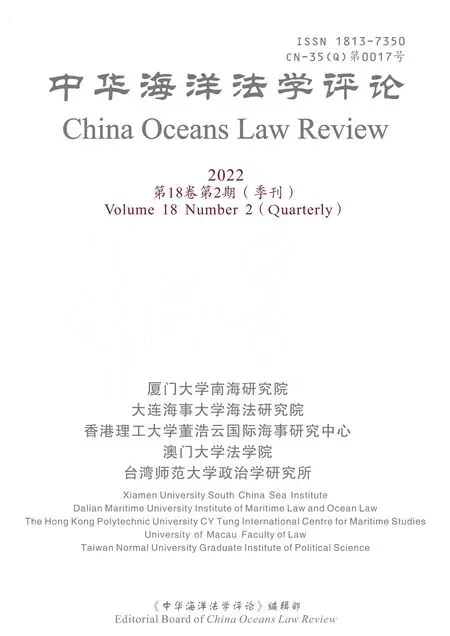China's Research on Pacific Island Countries(1978-2020)
DENG Yuncheng,ZHEN Feiyang
Abstract:Though less intertwined for a while due to geographical location,China and the Pacific island countries (PICs) have become increasingly close in the wake of China’s Reform and Opening-up and the independence and development of PICs.By employing measurement methods,this paper evaluates the current status and topic space-time distribution of research achievements on PICs by scholars in China.The findings show that there is a rapid development of research on PICs in China,featuring localization of research perspectives,diversification of research objects,synthesis of research purposes and policy-oriented research hotspots.These achievements serve as intellectual support for building a community with a shared future between China and PICs.This paper also proposes to expand the research outreach and depth,consolidate the fundamental research,and improve the supporting mechanism in order to pursue in-depth research on PICs.
Key Words:Pacific island countries (PICs);Topic space-time map;Academic research;Measurement methodology
I.Introduction
Since the Reform and Opening-up,China has engaged in increasingly close relations with Pacific island countries (PICs) (see Figure 1).1The Pacific island countries mentioned in this paper refer to the 14 countries located in the South Pacific except for Australia and New Zealand.They include Fiji,Samoa,Papua New Guinea,Vanuatu,Micronesia,Cook Islands,Tonga,Niue,Kiribati,Solomon Islands,Nauru,Palau,Tuvalu,and Marshall Islands.This is followed by an increasing stream of research on PICs by Chinese scholars,and some have conducted reviews and summaries of this field (see Table 1).These studies have fleshed out the academic community’s understanding of the domestic research status of PICs,and are characterized by a strong overview and an excessive focus on sorting out the development course,dividing the stages and discussing the current status of domestic research on PICs.Available studies that employ the measurement methodology have a strong descriptive and weak scientific reasoning character as they are heavy on describing the status quo.From the perspective of policy decisions,research results are an important object of use.According to some scholars,the use chain of information consists of seven stages,i.e.research,cognition,reference,achievement,adoption,implementation and influence.2Knott Jack &Aaron Wildavsky,If Dissemination Is the Solution,What Is the Problem?Knowledge,p.537-578 (1980).In practice,it is surely a dynamic cycle of iteration,in which information migration,transformation and exchange persist.As a result,the field,topic and depth of research will shape policy decisions to a certain extent.In view of the foregoing,this paper seeks to explore thestatus quoand the topic space-time distribution of studies on PICs conducted by Chinese scholars during the period 1978-2020,analyzes their characteristics,and puts forward several suggestions for optimization.

Figure 1 Progress of China's engagement with PICs3Figure 1 is made by the authors hereof.See China’s Cooperation with the South Pacific Island Countries,Xinhuanet (24 Nov 2014),http://www.xinhuanet.com/world/2014-11/24/c_127245516.htm;National Development and Reform Commission,Ministry of Foreign Affairs &Ministry of Commerce,Vision and Actions on Jointly Building Silk Road Economic Belt and 21st-Century Maritime Silk Road,People’s Daily,29 March 2015,at 4;National Development and Reform Commission,State Oceanic Administration,Vision for Maritime Cooperation under the Belt and Road Initiative,GovCN (20 Jun 2017),http://www.gov.cn/xinwen/2017-06/20/content_5203985.htm;XI Jinping Pays State Visits to the Independent State of Papua New Guinea,Brunei Darussalam and the Republic of the Philippines and Meets with Leaders of the Pacific Island Countries that Have Established Diplomatic Ties with China in Papua New Guinea,World Affairs,Vol.74:23,p.6 (2018);XI Jinping Speaks with PNG’s Prime Minister James Marape on the Phone,China Youth Daily,27 October 2021,at 1.(in Chinese)
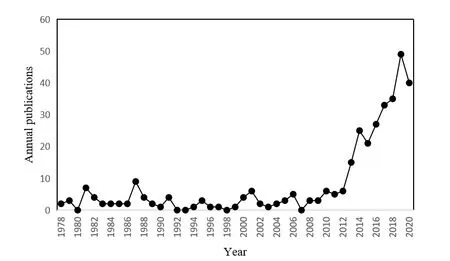
Figure 2 Interannual Literature Distribution of China's PICs Research(1978—2020)
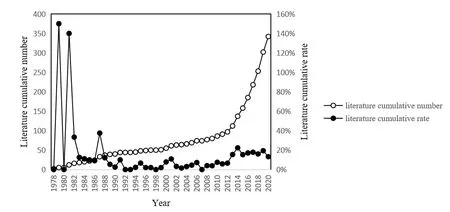
Figure 3 Cumulative Number and Cumulative Rate of China's PICs Research Literature (1978—2020)
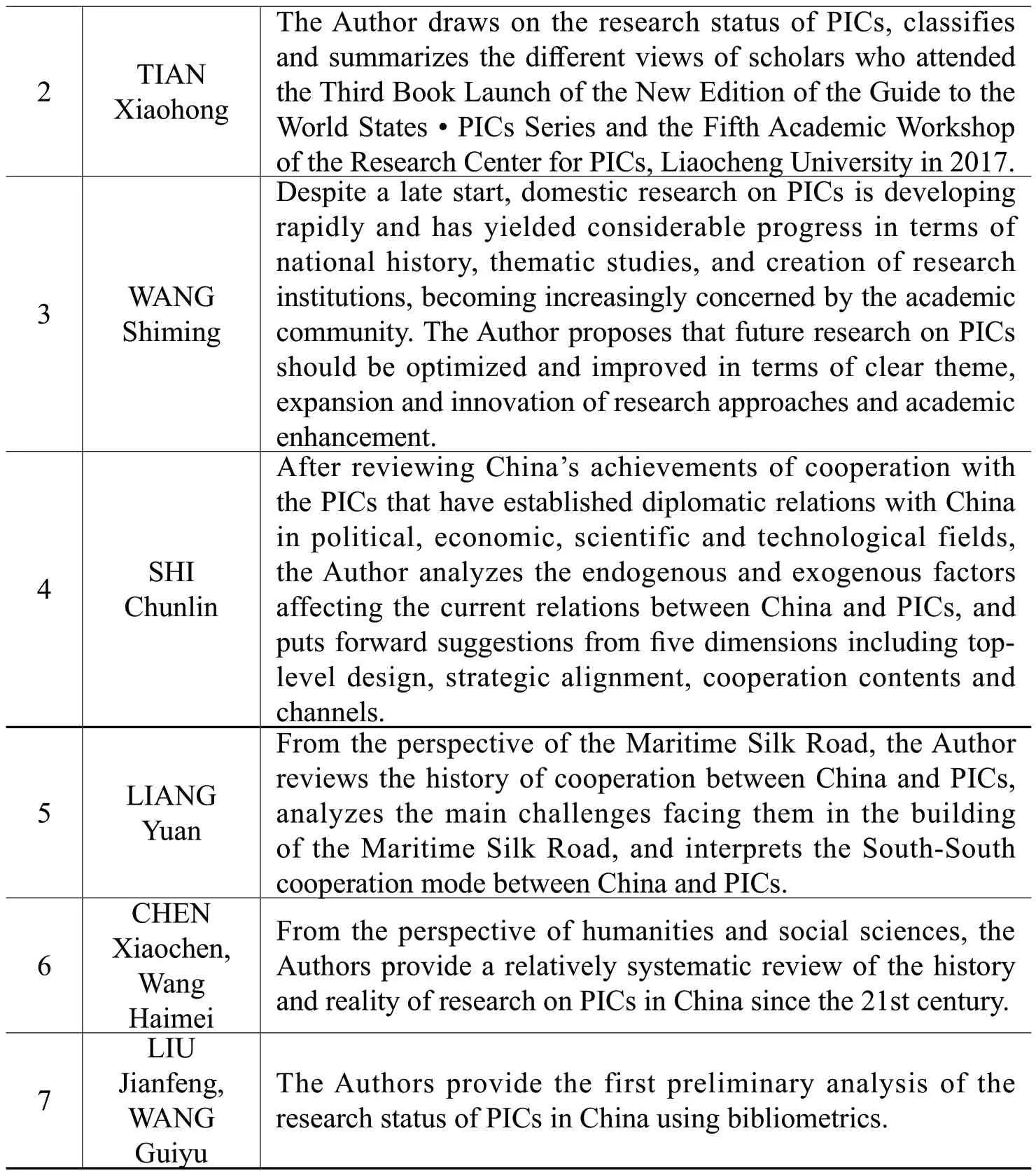
II.Research Methodology and Text Processing
A.Research Methodology
With respect to the analysis of the research status and topic space-time distribution,the bibliometric method using CiteSpace can provide a more intuitive analysis than other research methods such as text analysis,online survey,and social network analysis.5LI Jie,CiteSpace Chinese Guide,Sciencenet (18 Jul 2017),https://blog.sciencenet.cn/blog-496649-886962.html.(in Chinese)CiteSpace is a visual analysis software that presents the structure,pattern and distribution of scientific knowledge in the form of mapping knowledge domains (MKDs).A MKD features nodes,connecting lines,and their colors and shapes,which are important components and also breaches in the understanding of MKDs.“Having an understanding of mapping knowledge domains will help us to dig deeper into the knowledge structure of a specific field and the dynamics of its evolution,explore the frontiers and knowledge boundaries of discipline development,and capture the hot topics and development laws of this field.”6CHEN Yue et al.,Principles and Applications of Analyzing a Citation Space,Science Press,2015.(in Chinese)
B.Text Processing
To acquire more comprehensive and accurate data,this study employed the China National Knowledge Infrastructure (CNKI) database to obtain the sample literature.Given the difference in the usage of names of PICs in the academic community,a search was conducted for South Pacific,South Pacific island countries,Pacific Island Countries,SPICs,Papua New Guinea,Fiji,Kiribati,Cook Islands,Marshall Islands,Micronesia,Nauru,Niue,Palau,Samoa,Solomon Islands,Tonga,Tuvalu and Vanuatu,respectively.The time span was set from 1978 to 2020 in view of the delay in literature inclusion.After removing newspapers,standards,achievements and other types of literature,the search results were imported in refworks format into CiteSpace for file transcoding,de-duplication and data cleaning,and a total of 338 valid documents were obtained.
III.Visual Presentation of the Research Status of PICs in China
In this study,four indicators are selected to present the status quo of domestic research on PICs,namely interannual variation of literature,literature authors,literature issuing agencies,and co-occurrence of high-frequency keywords.
A.Interannual Variation of Literature
The interannual variation of literature allows visualization of the literature quantity and variation direction in different years within a given period of time,and gives an idea of the level of development and evolution of research topics in the academic community.As per Price’s exponential growth law of literature,7In the early stage of the development of research topics,results of the research were less in amount and grow relatively slowly due to the constraints of personnel,data and other objective conditions.Upon advancing to the rapid development stage,when there will be fewer personnel and data constraints,research results will increase at an exponential rate.there is a strong link between the literature quantity and the developments in the field of research.The “l(fā)iterature cumulative number” is the sum of the literature quantity of each year.The “l(fā)iterature cumulative rate” is the ratio of the literature quantity in the current year to the literature cumulative number in the previous year.They are the key indicators to judge the academic scale and the formation of research focuses,respectively.
According to Figure 2,there is a fluctuating upward trend of domestic research on PICs as a whole since 1978.Literature volume was below 10 articles per year before 2013,and began to rise significantly in 2013 and thereafter,with the most significant increase in the intervals of 2013-2014 and 2015-2019.Figure 3 indicates that the cumulative number of domestic research literature on PICs broke the 100 mark in 2013,and has thereafter grown rapidly.In addition,the literature cumulative rate curve in Figure 3 also suggests that 2013 is a critical time node.1978 to 2012 saw a largely fluctuating literature cumulative rate between 0% and 150%,which suggests an unstable stage of domestic research on PICs during this period.In 2013 and onward,the literature cumulative rate fluctuated slightly in each year and basically stabilized at about 20%,which indicates a stable trend and onset of rapid development of domestic Pacific island research during this period.The inter-annual distribution of literature,the literature cumulative number,and the literature cumulative rate corroborate each other,all demonstrating that 2013 is a critical year of data change.Based on Price’s exponential growth law of literature,the period from 1978 to 2012 can be regarded as the budding and accumulation stage of research on PICs in China,while the period of 2013 and onward can be regarded as the rapid development stage.Behind the foregoing variations lie the trends of China’s diplomatic policy.Considered as an extension of China’s southeastern periphery,the South Pacific region has been integrated into China’s“Pan-Peripheral” in the recent decade.8This is not officially documented,but it is supported by academic research.See QI Huaigao&SHI Yuanhua,China’s Peripheral Security Challenges and Pan-Peripheral Diplomatic Strategy,World Economics and Politics,Vol.27:6,p.25-26,p.156-157 (2013).(in Chinese)Since 2013 when Chinese President Xi Jinping formally proposed theBelt and Road Initiative(BRI),the South Pacific region,in its role as a natural extension of the BRI,has drawn increasing attention.9ZHANG Ying, The Belt and Road Initiative in South Pacific Island Countries,Pacific Journal,Vol.27:1,p.93 (2019).(in Chinese)2015 and 2017 marked the promulgation of two heavyweight documents (see Figure 1),which designated PICs as an important direction and key node of the BRI,thus greatly enhancing the strategic position of PICs in China’s neighborhood diplomacy and bringing the PICs research to the forefront of the academic community.
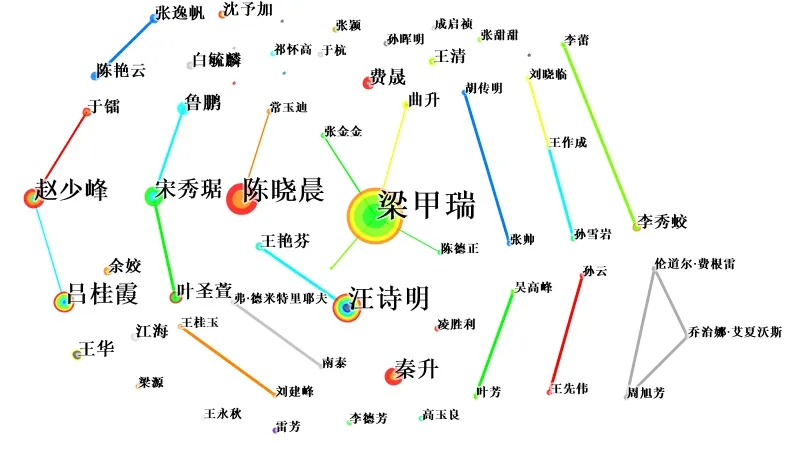
Figure 4 Author Collaboration in China's PICs Research (1978—2020)
B.Analysis of Literature Authors
In the analysis of literature authors,the number of authors’ publications and collaboration network are used as the basis to analyze the number of authors’achievements and the collaborative relationship among authors,in order to judge the academic productivity of scholars and the maturity of academic groups.10In order to better highlight the core authors and inter-author collaborations during the processing,this study adjusted the threshold appropriately without changing the original MKD structure.As shown in Table 2,Prof.LIANG Jiarui,Prof.WANG Shiming,Prof.CHEN Xiaochen,Prof.LYU Guixia,Researcher XU Xiujun,Prof.ZHAO Shaofeng,Researcher SONG Xiuju,and Researcher QIN Sheng are scholars with high contributions to the research on PICs in China,who have conducted an in-depth investigation on the modernization process of PICs,the BRI and PICs,the competition among major powers in the South Pacific region,and economic assistance,respectively.

Table 2 Ranking of Authors by the Number of Publications (Top 24)

It is a major feature of CiteSpace in visualizing literature to use nodes and connecting lines to show the collaboration,citation and co-occurrence among sample literature.In Figure 4,the size of the node represents the number of the scholar’s publications,by extension,his/her academic productivity.The color changes within the node denote the different years when the scholar published the papers,and the connecting line between nodes reflects the collaborative relationship between scholars.Figure 4 reveals that the academic productivity of different scholars varies greatly.Moreover,the thin and small number of connecting line among the nodes suggests a paucity of collaborative research among scholars,and a dearth of cross-institutional,cross-topic,and multi-scholar research results in particular,which is not conducive to the further advancement of PICs research in China.In this context,it is worth considering how to abandon the fragmented research situation,get rid of the dilemma of expressing opinions without regard to objective circumstances,and enhance the complementarity of PICs research in the academic community.
C.Analysis of Publishing Institutions
Similar to the analysis of literature authors,the analysis of literature publishing institutions is conducted based on such indicators as the institution’s number of papers published,cooperation network and geographical distribution to assist in determining the academic productivity and influence of the institutions.As shown in Table 3 and Figure 5,the research institutions focusing on PICs in China mainly consist of comprehensive universities,normal universities,academies of social sciences,etc.,mostly concentrated in their schools of international relations or regional research centers (institutes).Liaocheng University topped the list of research institutions in terms of the number of papers published with 53 papers,followed by the University of Chinese Academy of Social Sciences,Central China Normal University,Renmin University of China,Sun Yat-sen University and East China Normal University with 20,14,13 and 10 papers respectively to rank second to sixth.Suzhou University of Science and Technology and Tianjin Normal University both published 8 papers,ranking 7th and 8th,respectively.The last two of the top 10 institutions are Fudan University and Wuhan University in order,with 7 papers each.In addition,Fujian Agriculture and Forestry University (5 papers),Beijing Foreign Studies University (5 papers),Xiamen University (5 papers) and China Foreign Affairs University (5 papers) also contributed a large number of papers.Research institutions provide research platforms for scholars.Through comparison,it is found that there is a basic correspondence between the research institutions with the highest number of publications and the research units to which scholars with higher academic productivity belong.
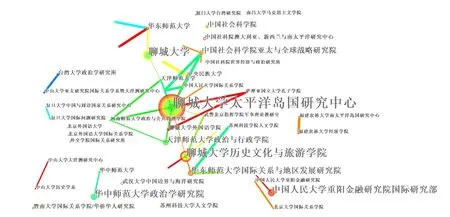
Figure 5 Distribution of Domestic Research Institutions for PICs Research in China (1978—2020)
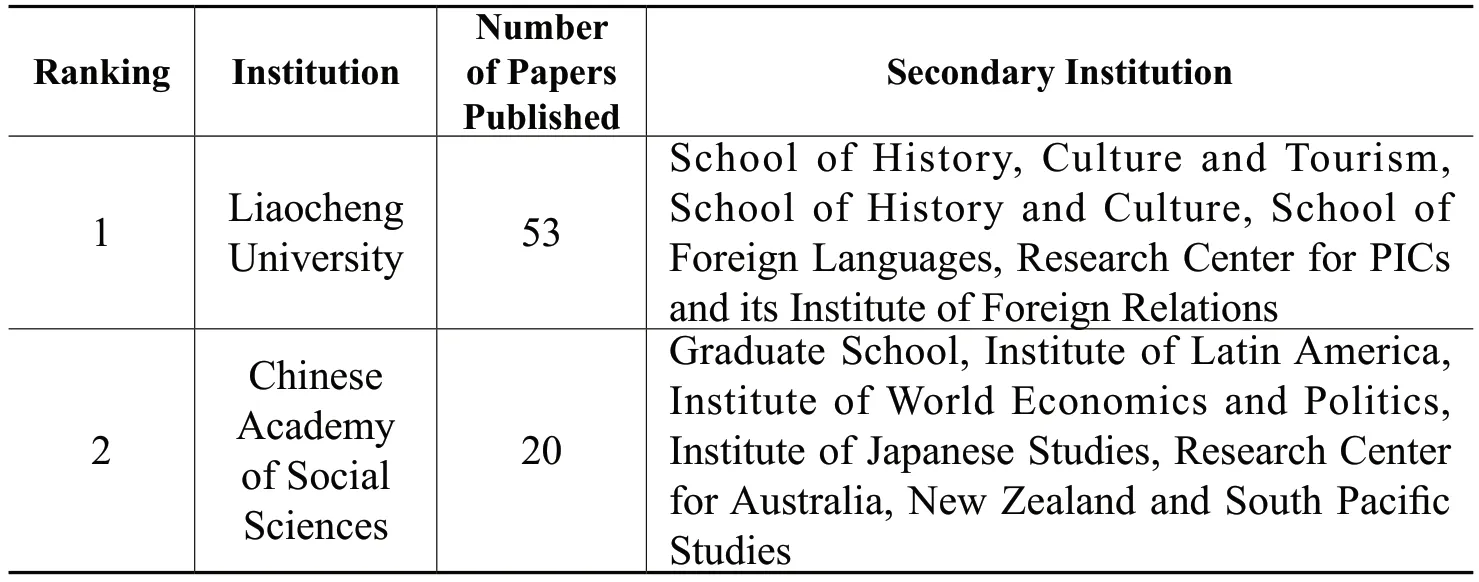
Table 3 Ranking of Research Institutions by Number of Publications

In terms of the geographical distribution of research institutions,those with a large number of publications are all located in coastal provinces,with an uneven distribution from east to west.In comparison,the distribution is relatively balanced from north to south.Recent years have witnessed the rapid development of the northern institutions on PICs research,represented by Liaocheng University,Chinese Academy of Social Sciences,Renmin University of China and Beijing Foreign Studies University,with a quick increase in their scientific research achievements In particular,Liaocheng University has integrated its advantageous resources of multiple disciplines in recent years,established the Research Center for PICs,and launched a series of achievements includingBlue Book of Pacific Island Countries:Annual Report on Development of Pacific Island Countries,Pacific Island Countries Research Newsletter,andResearch on Pacific Island Countries.Among them,theResearch on Pacific Island Countriesis China’s first professional collection of papers focusing on issues of PICs,centering on which an academic community of PICs research has gradually formed.Meanwhile,the southern research institutions represented by Sun Yat-sen University,East China Normal University,Central China Normal University,Wuhan University and Fujian Agriculture and Forestry University,have made fruitful achievements in recent years.A healthy situation of competition between the north and the south has gradually been shaped.The Center for Oceania Studies established by Sun Yat-sen University has published a series of blue booksAnnual Report on Development of Oceania.It can be observed from Figure 5 that there are relatively few co-occurrences among the research institutions.The closeness of the nodes arrangement is not high.This indicates that research institutions need to strengthen academic exchanges and collaborative development in order to enhance the complementarity of research and present higher-quality academic results.On the whole,the research institutions,especially the two Centers,have their own strengths and complement each other to flourish the research on PICs.
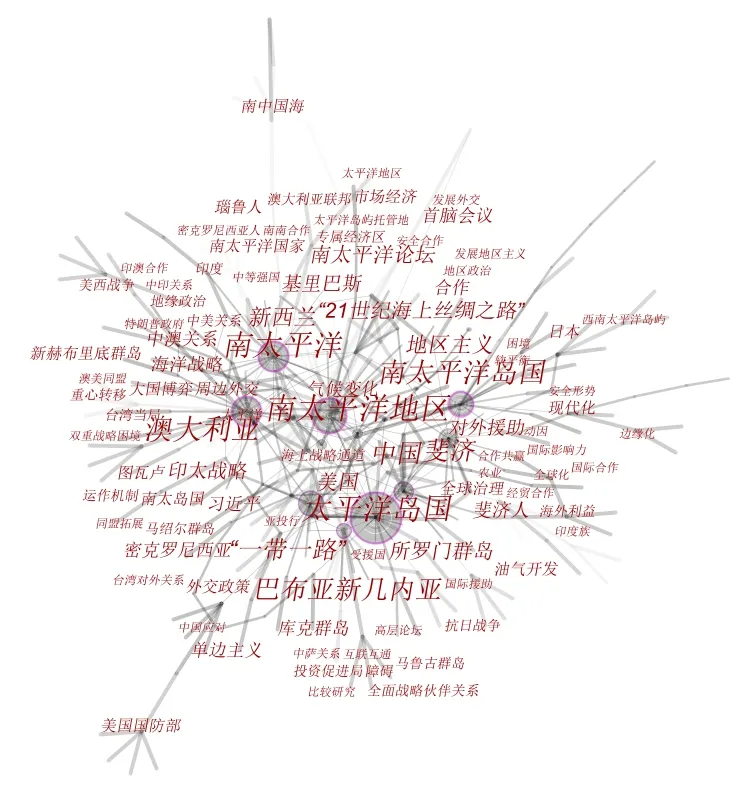
Figure 6 MKD of keywords in China's PICs Research (1978—2020)
D.Analysis of Keywords Co-occurrence
Keywords are the essence of a paper as the core condensation and main idea expression.The analysis of keywords co-occurrence allows a more intuitive discovery of research focuses in the field and their transitions,so that the changes in research focuses can be sorted out for a better understanding of the development and evolution of research topics.
Figure 6 presents a more comprehensive view of the development process of domestic research on PICs since 1978.The size of the node and the frequency of the keyword represented by the node are positively correlated,so are the frequency of the keyword and its research popularity.Therefore,the larger the node,the higher the frequency of the keyword,and the more popular the keyword in the research field.It is concluded that the above high-frequency keywords are highly correlated,and the domestic research focuses of PICs are basically unfolded and extended centering on the above high-frequency keywords.Together with Table 4,it is considered that domestic research focuses of PICs are mainly concentrated in the following five modules (see Table 5).To summarize,there is a trend of synthesizing and diversifying the research topics of PICs in China as scholars continue to explore them.

Figure 7 Topic space-time map of research on PICs in China from 1978 to 2020
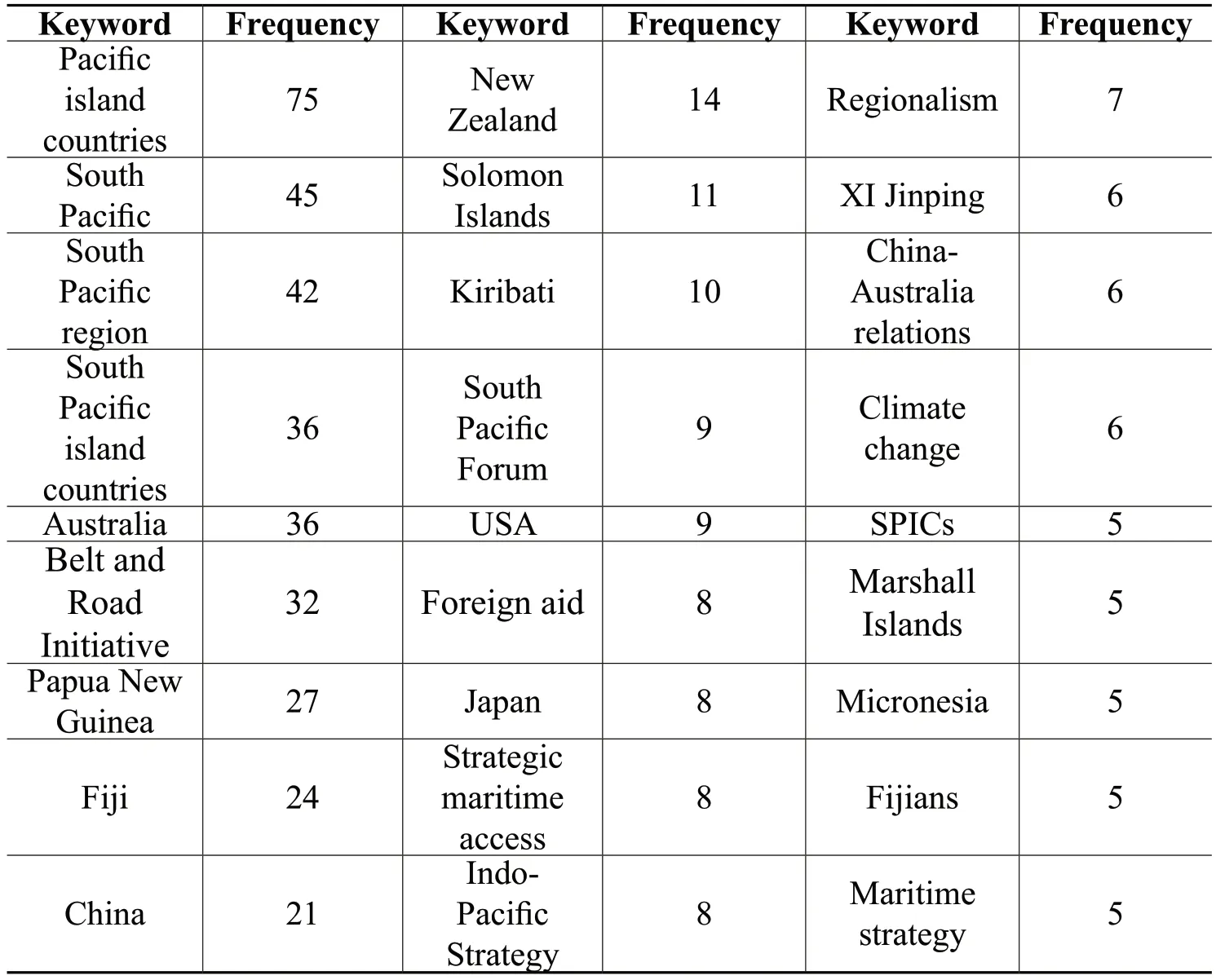
Table 4 Frequency of Occurrence of Keywords in China's PICs Research(1978—2020) (Top 30)

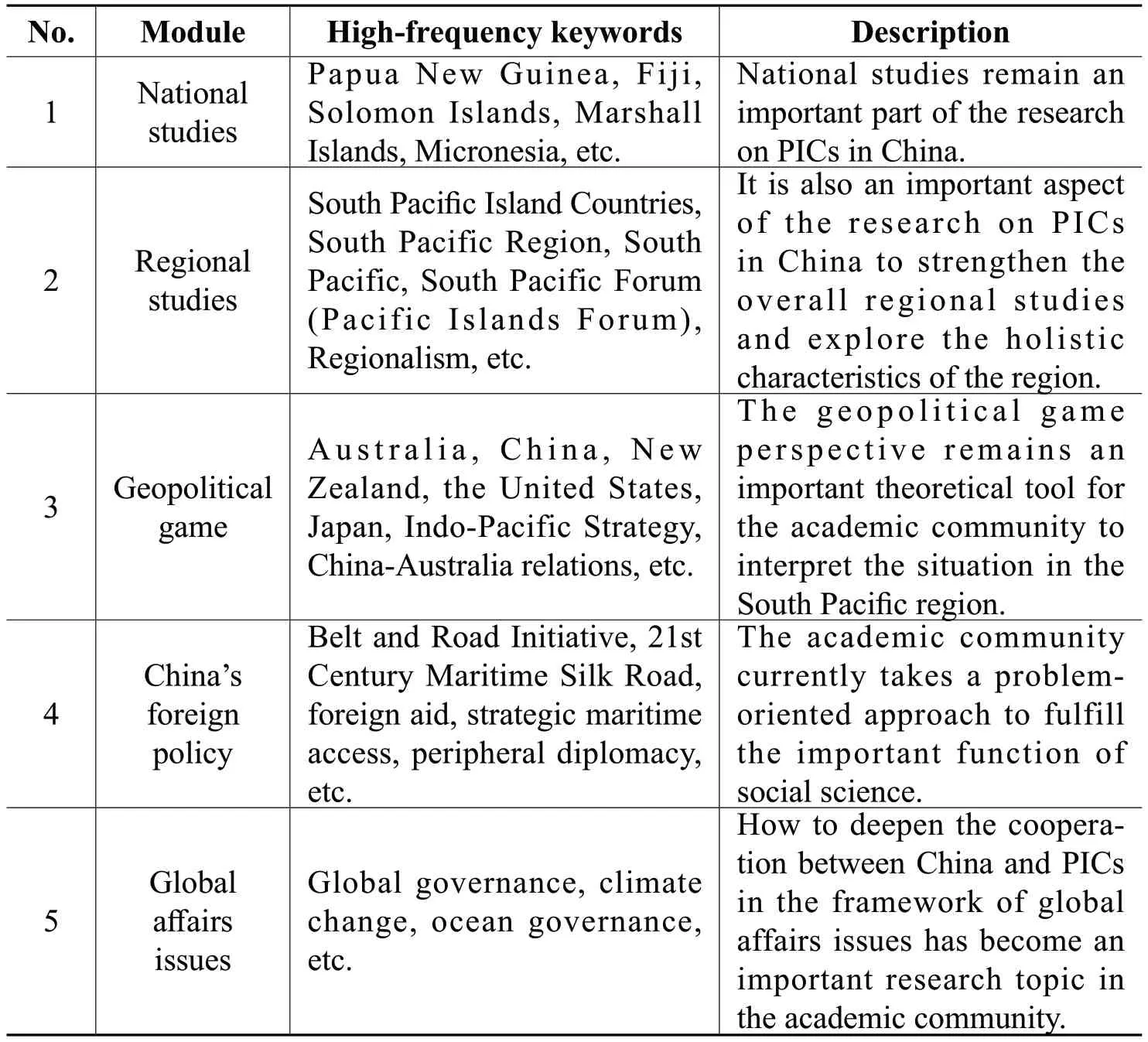
Table 5 Focuses Classification of China's PICs Research (1978—2020)
IV.Analysis of the Topic Space-Time Distribution of the Research on PICs in China
The topic space-time map can provide a clear picture of the transmutation of research focuses in this field,which can be analyzed to explore the path pattern of the research on PICs in China.
A.Change in Research Perspective:From Universal Research Primarily Based on Introductory Literature to in-depth Theoretical Research Targeting PICs
Early in the Reform and Opening-up,China began to establish diplomatic relations with the newly independent island countries in the South Pacific,bringing the South Pacific region gradually into the academic field of vision.A number of introductory papers introducing the geographical location,climatic characteristics,customs,and national institutions of the PICs were published inWorld Affairssuccessively,enriching the knowledge of the academic community about this region.XIANG An considered the then seven independent island countries as “micro states” and briefly described their economic development and climate change characteristics.11XIANG An,Micro-States in the South Pacific,World Affairs,Vol.48:3,p.21-22 (1981).(in Chinese)Focusing on Suva,the capital of Fiji,HAI Bin provided a sketch of the climatic characteristics,industry and education there.12HAI Bin,The Young Capital-Suva,World Affairs,Vol.46:8,p.23-24 (1979).(in Chinese)LI Taishun and CAI Chunhuai presented a detailed description of the characteristics of Fiji’s geography,food and cultural customs,as well as the highlights of Fiji’s economic development after independence.13LI Taishun &CAI Chunhuai,The Island Country on the Meridian-Fiji,World Affairs,Vol.37:9,p.27 (1981) .(in Chinese)CHEN Wenzhao shared the history,geographical features,customs and agricultural development of Western Samoa,and detailed the fishing characteristics there.14CHEN Wenzhao,The Island Country in the South Pacific-Western Samoa,World Affairs,Vol.35:12,p.24-25 (1979).(in Chinese)YU Hang gave an overview of Papua New Guinea’s development history,mineral resources,and education based on its actual situation.15YU Hang,Experience in Papua New Guinea,Global Review,Vol.5:8,p.10-12 (1985).(in Chinese)
The growth of the introductory literature has also drawn the attention of international relations scholars to the region.However,research on PICs has been strongly dependent for a relatively long period of time,as these island countries are not the direct objects of scholars’ research,but are embedded within the framework of “great power competition” and “regional great power studies”.In other words,“the research findings of this period are almost invariably embedded from the perspective of non-island countries,and their foothold is non-island countries rather than island countries.”16WANG Shiming,The Prospect of Research on Pacific Island Countries,Pacific Journal,Vol.25:9,p.86-95 (2017).(in Chinese)BAI Yulin considered the competition among the United States,Australia and the Soviet Union as unfavorable factors for the further development of PICs.17BAI Yulin,The Evolving South Pacific Islands,Contemporary International Relations,Vol.3:3,p.48-52 (1983).(in Chinese)By analyzing the intense US-Soviet rivalry in the South Pacific region in the 1980s,WAN Shuyu and LIU Yueming argued that the Soviet Union took advantage of the strong dependence of some island countries in the region at the beginning of their independence to strengthen economic infiltration and gain a firm foothold in the region.18WANG Shuyu,LIU Yueming,A Preliminary Analysis of the New US-Soviet Rivalry in the South Pacific,Contemporary International Relations,Vol.5:4,p.46-52 (1987).(in Chinese)Based on the change in Australia’s strategic focus,CHENG Qizhen concluded that Australia’s realistic and cautious approach to the chaotic situation in the Pacific islands was for the purpose of achieving its own interests.19CHENG Qizhen,Australia’s Strategic Focus Shift and Issues,International Studies,Vol.15:4 (1988),p.24-29,63-64 (1988).(in Chinese)According to WANG Fan,the struggle for dominance in the South Pacific region is a stage factor that affects the development of the US-Australia-New Zealand alliance.20WANG Fan, The Historical Evolution of ANZUS,International Forum,Vol.13:2,p.18-23,79 (2005).(in Chinese)CHENG Xiaoyong interpreted New Zealand’s foreign policy and considered New Zealand-PICs Relations as an important part thereof.21CHENG Xiaoyong, Regional Cornerstone of Small State Diplomacy:An Analysis of New Zealand’s Peripheral Diplomacy Policy,The Journal of Yunnan Administration College,Vol.11:2,p.136-140 (2009).(in Chinese)At this stage,research on PICs showed little independence and was mostly an affiliated area of other important topics.
Despite the remaining embeddedness and attachment to the research on PICs,there has been a yearly increase in the number of studies targeting the South Pacific region or PICs directly.On the one hand,recent years have seen a gradual shift in the academic community to consider the South Pacific region and PICs as an independent research segment and to provide targeted theoretical interpretations.Specifically,scholars have turned their attention to the economic and political modernization processes of these island countries,their foreign policies,and the development issues of the region.On the other hand,research on PICs has become more independent in that it has gradually become an important side of the bilateral or multilateral diplomacy research.In the past decade,many scholars have initiated studies on the policies of the United States,22See FANG Xuanye,Research on US Policy Toward South Pacific Island Countries During the Obama Administration,Master’s Dissertation,China Youth University of Political Studies,2018;WANG Chengzhi,US’s Strategic Rebalancing in the South Pacific and Its Impact on China,Fudan American Review,Vol.13:2,p.39-51 (2014);XIAO Huan &XIE Siqiang,Analysis of the Movement and Impact of US’s Strategic Adjustment in the South Pacific Region,Forum of World Economics and Politics,Vol.33:2,p.18-26,40 (2015);SONG Xiuju &YE Shengxuan,Brief Analysis on the New Development of the Relation between the U.S.and the South Pacific Islands under the Background of Asia Pacific Rebalancing Strategy,Pacific Journal,Vol.24:1,p.50-62 (2016).(in Chinese)Russia,23See LI Xiujiao &LI Lei,Analysis of Russia’s Return to Diplomacy in the South Pacific,Russian,East European and Central Asian Studies,Vol.37:4,p.101-113,157-158 (2017).(in Chinese)the European Union,24See CHEN Mingyue,Research on History and Current Situation of EU’s Aid to South Pacific Island Countries,Master’s Dissertation,Central China Normal University,2018.(in Chinese)France,25See YE Shengxuan &SONG Xiuju,France’s Asia-Pacific Strategy and China’s Response,Asia-Pacific Security and Maritime Affairs,Vol.24:2,p.111-119,125 (2018).(in Chinese)Germany,26See LIANG Jiarui,New Trends,Causes and Implications of German Policy Toward Pacific Island Countries,Deutschland-Studien,Vol.32:1,p.41-54,142 (2017);LIANG Jiarui,Germany’s Participation in Ocean Governance in the South Pacific:Approaches,Motivations and Implications,International Forum,Vol.21:1,p.127-142,159-160 (2019).(in Chinese)Japan,27See LIANG Jiarui,Japan’s Strategic Adjustment in the South Pacific Region and Its Impact on China,Journal of International Relations,Vol.3:5,p.108-126,157 (2015);CHEN Yanyun &ZHANG Yifan,Adjustment of Japan’s ODA Policy Toward South Pacific Island Countries and Its Characteristics,Journal of Northeast Asia Studies,Vol.2:4,p.41-44 (2013);JI Binchao,Study on Japan’s Aid to the Pacific Island Countries,Master’s Dissertation,Central China Normal University,2014;SONG Xiuju &YE Shengxuan,Japan-South Pacific Islands Relation and China’s Response,International Review,Vol.37:3,p.144-157 (2016).(in Chinese)South Korea,28See SUN Xueyan,Republic of Korea’s Diplomacy Toward the Pacific Island Countries,Journal of China’s Neighboring Diplomacy,Vol.2:1,p.198-210 (2016).(in Chinese)and Australia29See QI Qingdong,Analysis of Australia’s Aid to South Pacific Countries,Master’s Dissertation,China Foreign Affairs University,2016.(in Chinese)on PICs from the perspective of geopolitics,and relevant achievements are increasingly abundant,which also demonstrates the independent status of PICs in the research of international relations.
B.Change in Research Object:From Single to Multiple
In the early study of this field,words that appeared frequently were Solomon Islands,Fiji,Tuvalu,Cook Islands,etc.This indicates that the research objects in this stage were mainly island countries and were relatively single.For one reason,in the traditional perspective of international relations theory,a single national study was helpful to consolidate the research foundation of this field;for another reason,the PICs had been independent for a short period of time at that moment,and their governments were mostly focused on domestic governance issues,resulting in insufficient internal and external conditions to promote regional integration.As a result,the single national studies became the “main theme” of the scholars’ research path in the early stage.In the wake of the strong demand of island countries for economic development and the impact of climate change and ocean governance,however,intra-regional cooperation has gradually become the best choice for island countries.In this context,various regional and subregional organizations have gradually become important objects of research on PICs in China.In the case of regional organizations,for example,the South Pacific Forum is an important representative of regional organizations in the region.It was founded by PICs as a way to break away from the status quo of the South Pacific Commission being controlled by outside powers.The Forum currently undertakes the implementation of diverse cooperation mechanisms and also supports the fulfillment of concrete policies.Regional thematic regimes such as regional security regime,30XU Xiujun, Regionalism and the Construction of Regional Order in the South Pacific,Doctoral Dissertation,Central China Normal University,2009.(in Chinese)regional ocean regime31QU Sheng,The Emergence,Development and Implications of the Regional Ocean Regime in the South Pacific,Pacific Journal,Vol.25:2,p.1-19 (2017).(in Chinese)and disaster management cooperation system32SONG Xiuju,LU Peng,A Brief Analysis on the System of Disaster Management Cooperation in South Pacific Regions,Socialism Studies,Vol 36:6,p.161-166 (2014).(in Chinese)in the South Pacific have gradually become important objects of scholars’attention.In parallel,the policies issued by various organizations and their changes have also received a certain degree of attention.For example,SONG Xiuju and LU Peng opined that the proposedPacific Planis of great significance to strengthen regional integration cooperation.33LU Peng &SONG Xiuju,An Analysis of the Role of PIF in Regional Integration and an Appraisal of Pacific Plan,International Forum,Vol.16:2,p.26-31,80 (2014).(in Chinese)Meanwhile,sub-regional organizations have also gradually gained the concern of scholars.In terms of cultural and ethnic identity,the South Pacific region is mainly composed of three ethnic cultures:Melanesia,Micronesia and Polynesia.With different ethnic cultures shaping diverse political thinking patterns and institutions,differences have been formed among sub-regions and affected the development process of regional integration.In this respect,CHEN Xiaochen made a research on the Melanesian Spearhead Group by mainly studying its formation background,development history,main achievements,motive force for growth,influences and constraints,and gave an outlook on its development trend.34CHEN Xiaochen,Melanesian Spearhead Group:A Study on the Development of A Subregional Organization,Area Studies and Global Development,Vol.4:5,p.51-67,156 (2020).(in Chinese)It should be emphasized that rather than fading away,the research on island nations is increasingly valued.TheGuide to the World Nations -PICs Seriesedited by scholars from Liaocheng University has been published.This series gives a comprehensive and detailed introduction to the PICs,which has strengthened the research foundation of the academic community.In conclusion,the diversity of research objects implies that this research field has attracted more scholars’attention and has entered a period of rapid development.
C.Change in Research Purpose:From Regional Research That Explores the “Commonality” of Island Countries as a Whole to Parallel Research that Explores the “Commonality” of Regions and the “Individuality” of Countries
PICs,South Pacific,South Pacific region and SPICs are the high-frequency keywords in this research field (see Table 4).Taking into account their space-time distribution,it is found that the early stage was characterized by scholars focusing on exploring the commonalities among the island countries as a whole.For one reason,there were strong similarities among the South Pacific islands in terms of their geographical location,historical development,local conditions and customs;for another reason,comparative studies were difficult to implement due to the limited availability of information and the inability to systematically sort out the specific conditions of each island country.With China’s increasingly close relations with the PICs,the situation has changed.In the case of national studies,the “individuality” embedded in the economic development,political modernization process and foreign policies of PICs has been gradually unearthed by scholars.Regarding the modernization process of PICs,for example,CHEN Mingyan delved into the historical process of Fiji’s political modernization from 1871 to 1970 by following two clues,i.e.the promotion of British colonial rule and the awakening and struggle of Fijians’ political consciousness,and taking the three pillars of Western democratic politics,namely parliamentary system,universal suffrage and party politics,as indicators.35CHEN Mingyan,The Study of Fiji’s Political Modernization Process (1871-1970),Master’s Dissertation,Liaocheng University,2017.(in Chinese)Regarding foreign policy research,ZHAO Shaofeng presented an analysis of Tuvalu’s foreign policies,holding that its policies embody the characteristics of small-state diplomacy and focus on peripheral diplomacy,with an aim to obtain more aid benefits.36ZHAO Shaofeng,Analysis on Tuvalu’s Foreign Policy and Foreign Relations,Journal of Liaocheng University (Social Science Edition),Vol 31:2,p.69-76,129 (2017).(in Chinese)In the case of regional studies,the island development patterns and the construction of regional order are two main lines of scholars’ research.For one thing,the development of island countries affects the regional power pattern to some extent,which in turn shapes the regional order;for another thing,the established regional order constrains the choice of future development patterns of island countries.Regarding the development patterns of PICs,LEI Fang and ZHANG Zhibing reviewed the achievements made by PICs in political and economic modernization and the dilemma facing them,and proposed four prongs to pull PICs out of the modernization dilemma,i.e.independence,economic reform,scientific and technological catching-up and regional cooperation.37LEI Fang &ZHANG Zhibing,Study on the Modernization of South Pacific Island Countries,Theory and Practice of Contemporary Education,Vol.3:9,p.157-159 (2011).(in Chinese)Based on the status quo of PICs,WANG Shiming and WANG Yanfen got rid of the traditional perspective of modernization theory and held that the uniqueness of island countries in nature and history determines the particularity of their modernization path,and pointed out that their own efforts,regional unity and foreign aid are the keys to their modernization success.38WANG Shiming &WANG Yanfang,A New Perspective on the Modernization Process of Pacific Island Countries,Journal of Soochow University (Philosophy &Social Science Edition),Vol.35:4,p.177-184,192 (2014).(in Chinese)CHEN Hongqiao made a study on the structure,development and status quo of regional ocean governance in PICs,and concluded the insights from the perspectives of decision-making transparency,intellectual support,and power-responsibility relationship.39CHEN Hongqiao,Exploration on Regional Ocean Governance in the Pacific Island Countries,Journal of Strategy and Decision-Making,Vol.8:4,p.3-17,103 (2017).(in Chinese)From the perspective of global ocean governance,LIANG Jiarui and QU Sheng sorted out the category,objects,subjects and norms of ocean governance in the South Pacific region,and extended the insights of ocean governance in the South Pacific to the global ocean governance.40LIANG Jiarui &QU Sheng,Ocean Governance of the South Pacific Region in the Perspective of Global Ocean Governance,Pacific Journal,Vol.26:4,p.48-64 (2018).(in Chinese)Regarding the construction of regional order,XU Xiujun opined that regionalism in the South Pacific has exerted a great influence on the construction of order in the South Pacific and contributed to the transformation of the regional order in the South Pacific.41Supra note 28,SUN Xueyan.
D.Change in Research Focuses:Taking a “Problem-response” Orientation to Fit the Trend of National Foreign Policy,Highlighting the “Chinese Characteristics” in the Research on PICs
This research field has seen the emergence of new terms such as the BRI,21st Century Maritime Silk Road,a community with a shared future for mankind,global governance,and ocean governance in recent years (see Figure 7).These terms fit well with China’s foreign policy trends.As an international cooperation initiative,the BRI requires both macro considerations from top decision-makers and academic analysis and theoretical support from scholars.By reviewing China’s achievements of cooperation with Pacific island countries under the framework of the BRI,SONG Xiuju and YE Shengxuan analyzed the internal and external factors affecting further cooperation,and proposed countermeasures and suggestions from three aspects:communication and coordination,leaders’ meeting mechanism and basic research.42SONG Xiuju &YE Shengxuan,The Belt and Road Initiative and China-Pacific Island Countries Cooperation,Contemporary World,Vol.23:8,p.69-72 (2016).(in Chinese)With similar ideas,XING Ruili reviewed the advances of the BRI in the South Pacific region from the aspects of connectivity in policy,infrastructure,trade,finance and people-to-people ties,analyzed the challenges facing China in promoting the BRI in the region from both internal and external,subjective and objective perspectives,and stressed the importance of establishing a new diplomatic philosophy and strengthening people-to-people and cultural exchanges.43XING Ruili,The Belt and Road Initiative in the South Pacific:Progression,Challenges and Measures,Journal of Boundary and Ocean Studies,Vol.3:3,p.92-107 (2018).(in Chinese)ZHANG Ying and LIANG Yuan put forward targeted,academic and practical countermeasures in light of the current challenges facing the BRI in the South Pacific region.44ZHANG Ying,The Belt and Road Initiative in South Pacific Island Countries,Pacific Journal,Vol.27:1,p.93-104 (2019);LIANG Yuan,Prospects for Cooperation Between China and Pacific Island Countries in the Context of the Maritime Silk Road,The Journal of South China Sea Studies,Vol.5:4,p.110-118 (2019).(in Chinese)
In addition,these new terms are closely related.China has put forward the goal of modernizing the national governance system and capacity,making it imperative to strengthen domestic governance.Moreover,the complexity of the global governance process is shaped by the multidimensional nature of subjects and the richness of topics in the global governance field.The involvement in global governance is therefore a favorable occasion for China to learn from advanced international governance experience and coordinate domestic and international governance patterns,and also an important embodiment for China to assume international responsibilities and establish a good international image.Ocean governance and climate change are not only the fields in which China is involved in global governance,but also prominent issues of global governance.Given a global nature of ocean and climate issues,it is necessary to integrate the idea of a community with a shared future for mankind in the international governance of oceans and global climate governance.45HUANG Huikang,Ten Frontier Issues Relating to Recent Development in the Law of the Sea,Journal of Boundary and Ocean Studies,Vol.4:1,p.5 (2019);HUANG Bo,DENG Yuncheng &ZHANG Xiangjun,Study on the Path and Direction of China-Fiji Climate Change Cooperation,The Journal of South China Sea Studies,Vol.4:4,p.101 (2018).(in Chinese)In the meantime,the BRI is the Chinese proposal that China has chosen as a path to participate in global governance,while the concept of a community with a shared future for mankind brings greater value guidance for further promotion of the BRI and contributes to the high-quality development of the BRI platform.46YANG Zewei,The Interaction between the Concept of Maritime Community with A Shared Future and the Construction of 21st Century Maritime Silk Road,Journal of Ocean University of China (Social Sciences),Vol.28:5,p.1 (2021).(in Chinese)
V.Suggestions and Prospects
Through a review and summary of the status quo and path of research on PICs in China,we can find that relatively fruitful achievements have been made in the current academic community,which have also expanded our horizons.Nevertheless,we acknowledge that the measurement methodology fails to take into account related works and other results,thus leaving certain shortcomings,47LYU Guixia,Research on the Pacific Island Countries in China since the Start of Reform and Opening Up:Progress,Characteristics and Prospects,Journal of Boundary and Ocean Studies,Vol.7:1,p.70 (2022).(in Chinese)but the findings still have a high reference value.For future research,the following aspects are suggested to be improved:
First,we should expand the outreach and depth of research on PICs.In contrast to relatively mature research fields,the current research on PICs in China is still in the exploratory stage,thus necessitating three-dimensional and all-round coverage,broadened research ideas,and in-depth multi-perspective perceptions of PICs.At the country level,there is a need to focus on new issues such as the2050 Strategy for the Blue Pacific Continentand ocean finance,48Scholars have already started to focus on this topic.See CHEN Xiaochen,The Blue Pacific in Multiple Contexts -Pacific Island Countries’ Response to the New Geopolitical Environment,Contemporary World and Socialism,Vol.41:5,p.149-158 (2021);DENG Min,YE Fang,HE Yixiong,JIANG Xia &DENG Yuncheng,Prior Study on the Implementation of Marine Financial Cooperation between China and Pacific Island Countries,Hainan Finance,Vol.29:5,p.51-62 (2022).(in Chinse)in addition to the traditional issues,and to assess the impact of island countries on regional integration.At the regional level,the growing strategic importance of the South Pacific region and its role as a site for the game among international powers opens up new possibilities for the region or the countries involved to diversify their development.49ZHAO Shaofeng &WANG Wenzhe,Cooperation Between China and Pacific Island Countries in the Background of Major Powers Competition,Forward Position,Vol.27:3,p.50-51 (2020).(in Chinese)At the global level,despite their small land area,PICs are also important participants in addressing non-traditional security issues such as international smuggling,illegal human migration,marine protection and climate change,which are integral links in global governance and international industrial chains.
Second,we should firmly boost basic research.Solid basic research requires meticulous national studies and localized regional studies.In the absence of the above studies,there is no way to understand the development patterns of PICs.50Supra note 47,LYU Guixia,p.84-85.(in Chinese)To be specific,we must make the transition from introductory data collection and evaluative macro judgments to rule-based practical applications,as well as from grand narratives to in-depth studies of specific issues,or we will not be able to engage in dialogue with relevant scholars at the international level and contribute to the building of a community with a shared future.
Third,we should improve relevant supporting mechanisms to secure continuous and stable research.During the period 1978-2012,zero literature was available for multiple years (see Figure 2).There also exists a relative lack of topic vocabulary as highlighted in Figure 7,a deficiency in research fields and disciplinary layout,and a need to improve the continuity and stability of research.For future research,scholars should conquer the relatively unfavorable objective conditions such as late start and poor foundation of research,make fuller use of the policy of regional and national country studies,and proceed from the discipline construction,academic organization and research network construction and improvement to address the current problem of lack of mechanism guarantee.51See DENG Yuncehng &DENG Yingying,Rumination on Building A Network of Marine Social Science Think Tanks,Hainan Daily,28 November 2018,at A6.(in Chinese)At the operational level,the academic community should also embrace the participation of scholars from PICs to form effective and high-quality interactions and enhance the stability of research.
- 中華海洋法學(xué)評(píng)論的其它文章
- “藍(lán)色太平洋”愿景及其對(duì)太平洋島民的重要性與挑戰(zhàn)
- Understanding the Importance and Challenges of the “Blue Pacific” to Pacific Islanders
- 藍(lán)色經(jīng)濟(jì)視角下島嶼可持續(xù)發(fā)展的比較分析
- A Comparative Analysis of Measuring Island Sustainable Development through a Blue Economy Lens
- 太平洋島國(guó)研究之中國(guó)視角(1978—2020)
- 新時(shí)期海島調(diào)查制度與科技供給銜接初探
——《海島保護(hù)法》視域下以促進(jìn)海島可持續(xù)發(fā)展為導(dǎo)向

